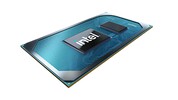AMD Ryzen 5 5600H vs Intel Core i5-11320H
AMD Ryzen 5 5600H
► remove from comparison
The AMD Ryzen 5 5600H is a processor for big (gaming) laptops based on the Cezanne generation. The R5 5600H has six of the eight cores based on the Zen 3 microarchitecture. They are clocked at 3.3 GHz (guaranteed base clock) to 4.2 GHz (Turbo) and support SMT for a total of 12 threads. The chip is manufactured on the modern 7 nm TSMC process.
The new Zen 3 microarchitecture offers a significantly higher IPC (instructions per clock) compared to Zen 2. For desktop processors AMD claims 19 percent on average and in applications reviews showed around 12% gains at the same clock speed.
In addition to the six CPU cores, the APU also integrates a Radeon RX Vega 7 integrated graphics processor with 7 CUs running at up to 1800 MHz. The dual channel memory controller supports DDR4-3200 and energy efficient LPDDR4-4266 RAM. Furthermore, 16 MB of L3 cache can be found on the chip.
Performance
The average 5600H in our database is in the same league as the Ryzen 5 6600HS and the Core i7-1260P, as far as multi-thread benchmark scores are concerned.
Thanks to its decent cooling solution and a long-term CPU power limit of 45 W, the Lenovo Legion 5 17 is among the fastest laptops powered by the 5600H that we know of. It can be roughly 30% faster in CPU-bound workloads than the slowest system featuring the same chip in our database, as of August 2023.
Power consumption
This Ryzen 5 series chip has a default TDP (also known as the long-term power limit) of 45 W, a value that laptop makers are allowed to change to anything between 35 W and 54 W with clock speed and performance changing accordingly as a result. A high-performance cooling solution is a must for a CPU like this.
The hexa-core APU is built with the 7 nm TSMC process for decent, as of late 2022, energy efficiency.
Intel Core i5-11320H
► remove from comparison
The Intel Core i5-11320H is a mid range SoC for thin and light gaming laptops and mobile workstations. It is based on the Tiger Lake H35 refresh generation and will be announced in Q3 2021. It integrates four Willow Cove processor cores (8 threads thanks to HyperThreading). The base clock speed depends on the TDP setting and can vary from 2.5 (28 W TDP) to 3.2 GHz (35 W). The boost of a single and two cores under load can reach up to 4.5 GHz. All four cores can reach up to 4.3 GHz. The L3 cache is reduced to 8 MB compared to the 12 MB of the higher end i7 models.
Thanks to the improved clock speeds, the performance gap to the faster i7-11370H should be quite small. The i7 still offers higher single and dual core Turbo speeds and more L3 cache.
The SoC also included the improved Xe graphics card with 96 CUs clocked at up to 1350 MHz.
Furthermore, Tiger Lake SoCs add PCIe 4 support (four lanes), AI hardware acceleration, and the partial integration of Thunderbolt 4/USB 4 and Wi-Fi 6 in the chip.
The chip is produced on the improved 10nm process (called 10nm SuperFin) at Intel, which should be comparable to the 7nm process at TSMC (e.g. Ryzen 4000 series).
All articles on Tiger Lake can be found on our Tiger Lake architecture hub.
| Model | AMD Ryzen 5 5600H | Intel Core i5-11320H | ||||||||||||||||||||||||||||||||
| Codename | Cezanne-H (Zen 3) | Tiger Lake-H35 | ||||||||||||||||||||||||||||||||
| Series | AMD Cezanne (Zen 3, Ryzen 5000) | Intel Tiger Lake | ||||||||||||||||||||||||||||||||
| Series: Tiger Lake Tiger Lake-H35 |
|
| ||||||||||||||||||||||||||||||||
| Clock | 3300 - 4200 MHz | 3200 - 4500 MHz | ||||||||||||||||||||||||||||||||
| L1 Cache | 384 KB | 320 KB | ||||||||||||||||||||||||||||||||
| L2 Cache | 3 MB | 5 MB | ||||||||||||||||||||||||||||||||
| L3 Cache | 16 MB | 8 MB | ||||||||||||||||||||||||||||||||
| Cores / Threads | 6 / 12 | 4 / 8 | ||||||||||||||||||||||||||||||||
| TDP | 45 Watt | 35 Watt | ||||||||||||||||||||||||||||||||
| Technology | 7 nm | 10 nm | ||||||||||||||||||||||||||||||||
| Socket | FP6 | BGA1449 | ||||||||||||||||||||||||||||||||
| Features | DDR4-3200/LPDDR4-4266 RAM, PCIe 3, MMX, SSE, SSE2, SSE3, SSSE3, SSE4A, SSE4.1, SSE4.2, AVX, AVX2, BMI2, ABM, FMA, ADX, SMEP, SMAP, SMT, CPB, AES-NI, RDRAND, RDSEED, SHA, SME | DDR4-3200/LPDDR4x-4266 RAM, PCIe 4, 4 GT/s bus, DL Boost, GNA, MMX, SSE, SSE2, SSE3, SSSE3, SSE4.1, SSE4.2, AVX, AVX2, AVX-512, BMI2, ABM, FMA, ADX, VMX, SMEP, SMAP, EIST, TM1, TM2, HT, Turbo, SST, AES-NI, RDRAND, RDSEED, SHA | ||||||||||||||||||||||||||||||||
| iGPU | AMD Radeon RX Vega 7 ( - 1800 MHz) | Intel Iris Xe Graphics G7 96EUs (400 - 1350 MHz) | ||||||||||||||||||||||||||||||||
| Architecture | x86 | x86 | ||||||||||||||||||||||||||||||||
| Announced | ||||||||||||||||||||||||||||||||||
| Manufacturer | www.amd.com | ark.intel.com | ||||||||||||||||||||||||||||||||
| max. Temp. | 100 °C |
Benchmarks
Average Benchmarks AMD Ryzen 5 5600H → 100% n=47
Average Benchmarks Intel Core i5-11320H → 87% n=47
* Smaller numbers mean a higher performance
1 This benchmark is not used for the average calculation












